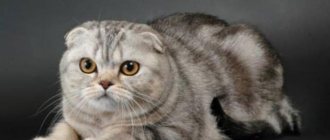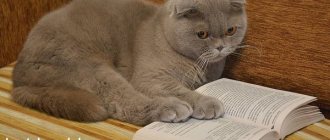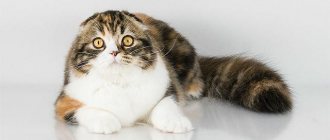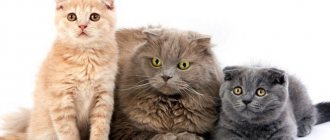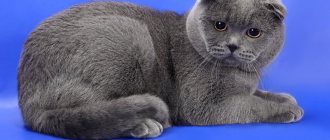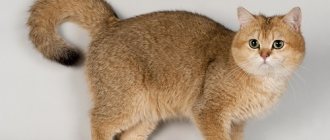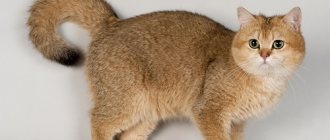The colors of Scottish cats (photos and descriptions of which are presented in the article) can have up to 100 different shades. The color of an animal's fur directly depends on genetics.
Two genes are involved in the formation of color in Scots: black and red, which, depending on the type of manifestation (by recessive or dominant trait), form one or another shade of coat. The color saturation is regulated by the third gene (diluent). Thus, when diluting the main black color, it turns out blue. The diluted red shade turns into cream, and the chocolate shade turns into purple.
A white shade of fur occurs when there is no color or complete suppression of the genes responsible for colorization. Over many years of breeding work, experts have bred cats of various colors: one- and two-tone, with or without patterns.
Basic (solid)
Solid colored Scottishfolds (photos below) are the main color type today. Their peculiarity is that there cannot be any inclusions of a different color. The animal's hair should be uniform and uniform along its entire length.
The most common color is still blue. Chocolate, red or white cats are still rare.
Blue
The Scottish Fold cat, the blue variety shown in the photo below, has a gray coat with a pronounced blue tint. The shade of the undercoat can be either light or dark. With this type of coloring, the animal’s paw pads and nose also have a gray tint.
White
The white Scottish Straight can have different eye colors (blue, bright orange, amber or honey). If a Scottish kitten had blue or black ancestors, there is a possibility of dark spots appearing on the scruff of the neck. By the time they grow up, the marks should normally disappear.
Black
The black Scottish cat has a bright coat color. A couple of white spots are considered completely acceptable. But if an animal has red or brown markings, this is direct evidence that it is not purebred. The nose and paw pads of an ebony Scot should also be black.
Chocolate
A chocolate-colored Scottish Fold cat (a photo of the breed with its distinctive characteristics is presented below) has a warm, uniform coat color, copper or yellowish eyes, and light brown toe pads and nose.
Red (red)
The red color variety is quite rare because it is very difficult to breed. (Red couples often have children with the pattern.) A Scotsman with this coat color should have pink nose and paw pads.
Brown
The brown color is an intermediate shade between red and chocolate. The nose and fingers (pads) are colored beige or pink-brown.
Lilac
The lilac color of Scottish cats, or lavender, has a pinkish tint to the fur. The mucous membranes of the animal are also pink.
Faun
The so-called deer (or light lilac) color suggests a light beige range of shades of the animal’s coat. The cat's nose, together with the pads, is pinkish in color.
Cinnamon
The cinnamon variety of cats has a lighter shade of hair than brown cats, but also has a beige or pinkish tint to the paw pads and nose.
Care and maintenance
Scottish Folds are rightfully considered one of the cleanest cats. They do not require complex care like Persians. Representatives of this breed take care of their fur themselves. They very quickly get used to going to the tray and, if there is a scratching post, they will never damage the furniture. Representatives of this breed will not cause trouble to their owners in the form of scattered things or torn curtains. They will not climb on shelves and throw off everything that comes under their paw.
If Fold stays alone at home for a long time, you need to come up with activities for him, choosing toys for your pet. These can be soft imitations of mice or rubber toys with springs.
Cats of this breed need to create their own place in the house. This could be a cozy bed in the form of a basket, or a house with tiers of platforms on which the cat can stretch.
Grooming
In Folds, the coat can be short (Scottish Fold) or semi-long (Highland Fold), while always remaining thick and dense. Short hair is easier to care for. The cat should be brushed once a week with a special mitten or brush that uses natural bristles. Semi-long wool is combed out with a special metal comb, the teeth of which are coated with Teflon.
The cat needs to be washed once a month. If the animal is preparing for an exhibition, then this will need to be done more often. You need to use special shampoos, selecting them for a specific coat color.
Claw care
The claws of domestic cats need to be trimmed, being careful not to touch the living part of the claw. This should be done once or twice a month.
Ear and eye care
You should clean your ears when plaque appears in them. For this, cotton swabs and a special liquid are used, which should be purchased at a pet store. If the kittens' eyes are running, they are instilled with special drops.
Tabbed
Taby color is the second most common color in the world. Its distinctive features are:
- a solid dark pattern in the form of spots or stripes on the coat;
- the “letter” M on the animal’s forehead;
- light spots on the back of the ears;
- white breast;
- “rings” on the tail and paws.
Important! Gray spots on the undercoat are a fault.
brindle
Brindle or tabby coloring suggests a distinct pattern of narrow stripes. The animal’s tail is also striped, and a kind of collar is “drawn” on the neck of the species.
Marble
The Scottish tabby cat can come in a variety of colors. The unifying feature of this variety is a distinct contrasting pattern, reminiscent of stains on marble.
Depending on the color of the animal, there are:
- golden you;
- cream;
- blue;
- marble on silver;
- silver;
- silver-blue;
- black marble;
- cameo.
Abyssinian
The ticked or Abyssinian variety of coat color suggests the presence of stripes along the length of the guard hairs. That is, the brightly pigmented base of the hair is replaced by a less pronounced color, the bright shade is repeated again, and so on. In addition, these animals are also characterized by stripes on their paws at an early age (the pattern disappears over time).
Spotted
With a spotted color pattern, spots clearly appear on the sides of the animal’s coat. They can be arranged in different orders: in a spiral (torn marble) or in the form of specks (torn strip).
How to feed Scottish Fold cats
Folds can be fed both natural food and special food, the main thing is not to mix them with each other. If preference is given to natural food, then the diet should be balanced and include the required amount of proteins, vitamins and macroelements.
The cat's menu must include meat (chicken, beef) and offal (liver, heart, lungs), boiled sea fish without bones. It is recommended to give your pet fermented milk products - low-fat cottage cheese, kefir, sour cream. Milk is given only to kittens up to 3 months old.
Folds benefit from porridge cooked in water or broth, pureed vegetables, and egg yolk. And also in the pet’s diet there must be grass, which helps cleanse the stomach. It should be purchased at pet stores, but not picked on the street.
Ready-made cat food is good because it already includes the necessary amount of nutrients necessary for the full development of the cat. Of course, we are talking about super premium food. This pleasure is not cheap, but you can’t skimp on your pet’s health. A castrated cat should be fed appropriate food.
In order for your pet to grow up healthy, you should take care of the feeding utensils, keep them clean, and provide the animal with access to fresh water.
An adult cat (after 8 months) should be fed 2 times, kittens - from 4 to 6 times.
With white
In the color of the Scots, white may be present in parallel with another shade. Depending on the “amount” of white on the animal’s body, several varieties of colors of these cats are distinguished.
Bicolor
Bicolor (two-color) implies from 30 to 70% white in the color of a cat. An additional shade may include:
- blue;
- cream;
- red;
- tabi.
As a rule, the paws, belly, neck, part of the muzzle and chest are white.
Harlequin
The originality of the harlequin's color lies in the white coloring of 4/5 parts of the animal's body. The tail, top of the head and ears should be black. The tip of the cat's nose is pink.
Vannes
The bath variety involves the presence of colored spots on the head (sometimes) and a colored tail.
Diseases, breed defects
The gene responsible for cute floppy ears is at the same time the culprit of hereditary diseases in Scottish cats. The following diseases pose the greatest danger.
- Osteochondrodystrophy . Pathology of the structure of the skeleton and musculoskeletal system. The disease manifests itself as an awkward gait, defects in the limbs, and painful sensations in them when jumping even from a small height. A short and thickened tail, enlarged joints, and a poorly developed lower jaw are clearly visible visual symptoms of the disease.
- Hypertrophic cardiomyopathy (HCM) . A heart disease that affects cats more than cats. The symptomatic picture is very expressive - the animal sits with its stomach pressed to the floor, its neck stretched forward and its elbows turned outward, breathing heavily through its mouth, the mucous membranes are bluish. In addition to cardiac pathology, ultrasound reveals fluid accumulation in the lungs. The prognosis for the course of HCM is extremely unfavorable.
- Hemophilia . Blood clotting disorders, the formation of extensive hematomas with different locations and the occurrence of prolonged bleeding as a result of injuries, as well as spontaneously.
Along with the possible inheritance of these diseases, Scottish Folds are at risk of developing eye and skin diseases, and ear infections.
Return to content
Shaded
Shaded coloring is characterized by a coloration in which only a third of the cat's hair is filled with color. The rest of the hair is white. Representatives of this variety have a light undercoat, shaded coloring on the sides, back, ears, tail and head. The chin, bottom of the tail and belly are highlighted in white.
Depending on the color of the “shading”, silver and golden varieties are distinguished.
Silver
The silver shaded color is characterized by a snow-white undercoat with dark gray tips of the hairs. The nose is brick, and the eyes are lined with black.
Golden
With a golden shaded color, the animal's fur has a light peach undercoat with a golden tint. The nose and paw pads are chocolate.
Character
All Highlands are very pliable and have a calm character. They are friendly towards all family members and absolutely non-aggressive.
They are very attached to the house and to the owner, they love care and attention to their person. But they won’t impose themselves either. They easily accept other pets and get along well with children, although there is a lot of talk about their touchiness and jealousy.
They don’t hide in front of guests, don’t run away, easily allow themselves to be petted and love to show off. The characteristic features of folds are:
- good learning ability;
- curiosity;
- understanding;
- calm;
- good nature;
- sociability.
Colorful
Colored or color-point are colors in which the main body color is light (white or cream), and the ears, muzzle, tail and paws have a darker shade. The Scots owe this rare color to their British ancestors, who had Persian cats in their family.
Tortoiseshell
The Scottish Fold cat of tortoiseshell color (photo below) has a coat on which dark spots are evenly combined with red or cream.
The following varieties of this color are distinguished:
- black-red;
- chocolate red;
- blue-cream;
- lilac-cream.
Important! Only cats can be tortoiseshells. Males of this color are a deviation from the norm.
Breed cost
For a purebred long-haired, fold-eared pet-class baby, nurseries ask from 10-15 thousand rubles. The animal is considered rare; even with the presence of the lop-eared gene, the baby’s ears do not always take the shape of a folded envelope. A pet without documents is offered for 2 thousand.
Sometimes the seller cannot always guarantee that the animal will have a characteristic trait in the future. At birth and until about 3-4 weeks of age, kittens' hearing organs are always located vertically.
How to choose a kitten
On the nursery's website you can see photos of a Highland Fold kitten and its parents. Necessary actions when choosing a kitten:
- touch the tummy; in a healthy baby it is soft, hard - arouses suspicion;
- inspect the area under the tail; it should be clean and dry;
- touching the tail, touches that are painful for the baby indicate the presence of a disease associated with changes in cartilage tissue. The flexible tail is not a concern;
- see the pets' parents or their photos;
- ask employees to show the place where the animal is kept before purchasing;
In turn, the cat's owners will provide all the necessary documents for the pet, as well as certificates of vaccinations and worming of the animal.
Nurseries
Catteries engaged in the breeding and distribution of Scottish fold cats with long hair in different cities:
| Moscow | Saint Petersburg" | Nizhny Novgorod | Novorossiysk |
| "Rumfold", breed elite Scottish Fold, American Shorthair cats | "Lukel" | "MILO" | Honeymur”, Scottish folds and Highland folds available |
| "Bel L'Mur", breeding of kittens | "RIONI" provide assistance with delivery | "Cat Man's" | "Mouse Nightmare", specialize in silver, gold colors |
| "The Way of the Great Queen" | "Grasse Nord" | "Krasnozar" | "Lubavushka" |
| "Mos Charm" | "Snow City", kitten delivery | "Maximillion" | "Royal Pride" |
In nurseries, the buyer will receive complete reliable information about the pedigree of the animal, advice on the care and education of their charges.
What to name a Scottish kitten
Eye colors
Scots eye color varies depending on the color variety:
- most Scottish cats have orange (orange) eyes;
- blue eyes are found in color-point and white animals;
- green – typical for golden, silver, smoky colors.
It is quite difficult to determine the type of color of a pet by eye. For this purpose, felinologists use a special color chart for Scottish cats. This makes it much easier to identify rare species. In addition, with the help of this tool you can determine by color the “correctness” of the upcoming mating of animals.
History of the origin of the Scottish Fold cat
The homeland of these wonderful creatures was Scotland, hence the name of the breed, which dates back to the 60s of the last century. On one of the village farms there lived a semi-wild tabby cat. One day she gave birth to offspring from an unknown cat; the litter included a female cub, a notable feature of whose appearance was the peculiar shape of the ears, as if folded into an envelope. The baby was named Susie.
The grown cat began actively producing kittens, which the farm owners barely had time to distribute to friends. One such unusual baby was acquired by a certain Mary Ross, who became unusually interested in the kitten’s non-standard appearance and even consulted with experts about this.
The new breed also made an impression on breeders, who began to crossbreed lops with the British. The result of the work of felinologists was the birth of the first representatives of the Scottish breed.
However, in the 70s, scientists established a ban on breeding fold-eared cats, citing the difficulty of treating ticks due to the unusual shape of the ears. In addition, most kittens were born deaf; many newborns had fusion of the vertebral joints and curvature of the limbs.
Breeders had to work hard to eliminate these features of the breed. They came to the conclusion that breeding folds is only possible with cats that have straight ears. As a result, one litter can contain both straight-eared (Scottish Straight) and fold-eared (Scottish Fold) babies. While the kittens are still small, it is impossible to determine what ears they will have later.
Their shape can be recognized no earlier than 3 weeks after birth. Externally, these two subspecies of the breed are the same, the only difference is in the shape of the ears: on folds the ears are lowered and folded, while on straights they will stand up.
By the way, Scottish Straight and Scottish Fold are not all varieties of Scots. There are also Highland Folds (long-haired folds) and Highland Straights (long-haired straight-ears).

